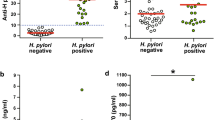Abstract
The mechanisms underlying acid secretory failure in patients with HIV disease are unknown. We evaluated, in a series of preliminary studies, changes associated with parietal cell structure and function in early and late HIV disease, in an attempt to elucidate possible underlying mechanisms. Gastric acid and intrinsic factor secretion, vitamin B12 absorption, and light and electron microscopic evaluation of gastric mucosa were evaluated in patients with early and late HIV infection (AIDS) and compared to non-HIV-infected controls. Immunolocalization of HIV-related antigens in gastric mucosa was also examined. Fasting gastric juice pH and intrinsic factor (IF) concentration in AIDS and HIV infected subjects were significantly different from controls (P=0.012 andP=0.025, respectively for pH, and 0.029 and 0.035 for IF; ANOVA LSD test). By contrast, maximal acid output (MAO) was significantly lower in AIDS, but not HIV-infected subjects (P=0.043 andP=0.322, respectively). Similarly, Schilling test phases 1 and 2 results were significantly lower in AIDS, but not HIV-infected subjects. Varying degrees of vacuolar degeneration of parietal cells were seen on light microscopy. On electron microscopy (EM), tubulovesicles were reduced and intracellular canaliculi dilated with striking loss of microvilli. Immunofluorescent staining with antibodies to gp120, gp41, p24, and p17 demonstrated positive punctate signals in the cytoplasm of gastric glands, which includes parietal cells. Immunogold EM with anti-gp120, localized predominantly to the microvilli of intracellular canaliculi in parietal cells. Abnormal secretory function of parietal cells occurs early in HIV disease, affects acid as well as intrinsic factor secretion, and is associated with morphological changes in the acid secretory apparatus.
Similar content being viewed by others
References
Lake-Bakaar G, Quadros E, Beidas S, Elsakr M, Tom W, Wilson DE, Diacsoy HP, Cohen P, Straus EW: Gastric secretory failure in patients with the acquired immunodeficiency syndrome (AIDS). Ann Intern Med 109:502–503, 1988
Belitsos PC, Greenson JK, Yardley JH, Sisler JR, Bartlett JG: Association of gastric hypoacidity with opportunistic enteric infections in patients with AIDS. J Infect Dis 166:277–284, 1992
Herzlich BC, Schiano TD, Moussa Z, Zimbalist E, Panagopolous G, Ast A, Nawabi I: Decreased intrinsic factor secretion in AIDS; relation to parietal cell acid secretory capacity and vitamin B12 malabsorption. Am J Gastroenterol 87:1781–1788, 1992
Shaffer RT, LaHatte LJ, Kelly JW, Kadakia S, Carrougher JA, Keate RF, Stames EC: Gastric acid secretion in HIV-1 infection. Am J Gastroenterol 87:1777–1780, 1992
Lake-Bakaar G: AIDS gastropathy: Prevalence and progression. An update. Gastroenterology 100:A592, 1991
Herbert V, Fong W, Gulle V, Stopler T: Low holotranscobalamin II is the earliest marker for subnormal vitamin B12 (cobalamin) absorption in patients with AIDS. Am J Hematol 34:132–139, 1990
Burkes KL, Cohen H, Krailo M, Sinow RM, Carmel R: Low serum cobalamin levels occur frequently in AIDS and related disorders. Eur J Hematol 38:141–147, 1987
Lake-Bakaar G, Tom W, Lake-Bakaar D, Gupta N, Beidas S, Elsakr M, Straus E: Gastropathy and ketoconazole malabsorption in the acquire immunodeficiency syndrome (AIDS). Ann Intern Med 109:471–473, 1988
Begley JA, Trachtenberg A: An assay for intrinsic factor based on blocking of the R binder of gastric juice by cobinamide. Blood 53:788–793, 1979
Boyum A: Separation of leukocytes from blood and bone marrow. Scand J Clin Lab Invest Suppl 21:1–114, 1968
Lim SG, Wyeth J, Donovan M, More L, Scott F, Dhillon AP: Gastric neuroendocrine cells, nerve fibers and gastric acid in HIV patients. Int Conf AIDS 9(1):445, 1993 (abstract PO-B19-1857)
Remacha AF, Riera A, Cadafalch J, Gimferrer E: Vitamin B12 abnormalities in HIV infected patients. Eur J Haematol 47(1):60–64, 1991
Zeitz M, Ullrich R, Heise W, Bergs C, L'Age M, Riecken EO: Malabsorption is found in early stages of HIV infection and independent of secondary infections. Int Conf AIDS 7(2):46, 1991 (abstract WB90)
Harriman GR, Smith PD, Horne MK, Fox CH, Koenig S, Lack EE, Lane HC, Fauci AS: Vitamin B12 malabsorption in patients with acquired immunodeficiency syndrome. Arch Intern Med 149:2039–2042, 1989
Luu J, Bockus D, Remington F, Bean MA, Hammar SP: Tubuloreticular structures and cylindrical confronting cisternae. A review. Hum Pathol 20(7):617–627, 1989
Orenstein JM, Simon GL, Kessler CG, Schulof RS: Ultrastructural markers in circulating lymphocytes of subjects at risk for AIDS. Am J Clin Pathol 84(5):603–609, 1985
Ozick L, Chander P, Agarwal A, Soni A: Tubuloreticular inclusions in colonic mucosa as diagnostic markers of AIDS. Am J Gastroenterol 84(2):193–197, 1989
Author information
Authors and Affiliations
Rights and permissions
About this article
Cite this article
Lake-Bakaar, G., Elsakr, M., Hagag, N. et al. Changes in parietal cell structure and function in HIV disease. Digest Dis Sci 41, 1398–1408 (1996). https://doi.org/10.1007/BF02088565
Received:
Accepted:
Issue Date:
DOI: https://doi.org/10.1007/BF02088565




